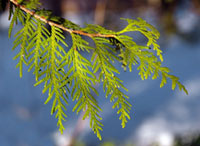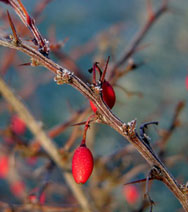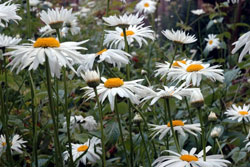Tough Plants for Tough Places:
Clay Busting Plants

Ah, the glory of clay! The potter's delight, it can be made into anything, except a beautiful garden. Or can it? From Connecticut to Georgia; from Arizona to West Virginia, most native soil is clay, clay, clay. No need to panic! Those new home sites and the backyard pile of rubble, left over after the county put in the new sewer line, can become a lush haven for many trees, shrubs, and perennials. If you can work it, and you maintain the surface moisture level during dry periods, many clay-busting plants will not only grow, but they will flourish, and do so rapidly.
The following is a list of my favorite clay-loving plants:
Trees:
Thuja 'Green Giant' (Thuja)

This western red cedar cross is one of the fastest growing conifers in the world. Its foliage is a lush, deep green, and it grows at an amazing rate of 3 to 5 feet a year. Its heavenly scented evergreen branches ascend gracefully, and it never needs trimming. It is an ideal choice for a privacy screen. Very long lived, 'Green Giant' is deer, pest, and disease resistant. A real traffic stopper, this lovely evergreen will grace your yard for generations to come. Height 30-50 feet. Full sun to light shade. Zone: 5-9.
River Birch (Betula nigra)
This fast growing native birch loves to keep its feet wet, survives for weeks in standing water, and it is immune to the bronze birch borer, which has blighted and killed many stands of birch trees in the middle Atlantic and south eastern states. River Birch loves low swampy places, and its thirsty roots blast through tough clay soil. The peeling bark of mature trees and the beautiful gold autumn color make this graceful tree a lovely addition to the landscape. Grows to a height of 90 feet at maturity. Full to part sun. Zone 3-9.
Eastern White Pine (Pinus strobus)
This beautiful pine, with its blue-green needles, has it all. It will grow anywhere, thrives in clay soil, and can even tolerate wet swampy areas. Fast growing to 100 feet, it will tower above a one-story house in ten years. It is excellent for a specimen tree or windbreak, and the birds love it for nesting and food. It is widely used for Christmas trees and timber, but it also can be sheared back for the smaller yard. Full sun to part sun.
Bradford Flowering Pear (Pyrus calleryana 'Bradford')
This clay-loving flowering tree is a not to be missed addition to your yard. Its tiny pear fruits are preferred by cardinals and mocking-birds, and it is loved by all birds for its sheltering branches. It is the first tree to bloom in the spring and the last to shed its leaves in the fall. The leaves are a perfect leathery green in the summer, turning to a deep, burgundy red in autumn. Bradford is a fast growing tree that will soar over your house within 10 years. Plant in full sun or part shade. Height: 50 feet. Zone: 5-9.
Eastern Redbud (Cercis canadensis)
The purple-red, tiny grape-like blossoms of the redbud explode along every branch of this small under story tree in spring. It’s a breathtaking sight to behold on hillsides and in forest glades. This is a tree that deserves to be planted enmasse. From two year seedling to full-bloom takes about 5-6 years, and it is well worth the wait. After bloom, the heart shaped leaves appear delicate and shiny. Beautiful in the dappled shade of taller trees, Eastern Redbud thrives in clay soil, and its roots grow rapidly, but are non-invasive. Grow in partial shade or full sun. Zones: 4-9.
Flowering Crabapple (Malus)
Few flowering trees can compete with the glorious blooms of the flowering crabapple. From pink to white to deep rose, the blooms of this magnificent tree will tantalize from early April to late May, depending on the cultivar. The leaves are a leathery, healthy green in summer, and the fall color deepens to a rich burgundy in autumn. Tiny green to red “apples” appear nestled amongst the leaves all summer and into fall. They cling to the branches creating winter interest, until the birds eat them. My all time favorite flowering crab is Malus Scarlet 'Brandywine' which has blooms that are sweetly fragrant and look like little roses. Full sun. Zones: 4-9.
Shrubs:
Japanese Barberry (Berberis thunbergii)

A much underappreciated deciduous shrub, the Japanese Barberry is truthfully a beautiful specimen of a plant. With lush burgundy foliage, thorny stems, and bird friendly fall berries, the barberry is a perfect living fence. Truly a plant with three-season interest, in fall this incredible shrub turns a fiery red. Carefree and not at all fussy about soil, the barberry grows to a height of 6 feet, untrimmed. It also can be pruned to as little as 2 feet. Pollution and drought tolerant, it is disease and pest free. Full sun to light shade. Zone: 4-8.
Butterfly Bush (Buddleia)
Also known as the summer lilac, the gorgeous flowers of the heavenly scented butterfly bush are hummingbird and butterfly magnets. The long flower trusses give a never-ending show from summer right into fall. Plants can grow to a height of 10 to 12 feet, although it is recommended that they be cut back to 10 inches in late winter or early spring to promote lush growth and more flower power. There are many choices available, from Buddleia 'Strawberry Lemonade' with its variegated foliage and deep pink blooms to the towering honey-scented 'Davidii Black Knight' with black-purple blooms. For smaller yards, diminutive 'Purple Emperor' grows to a height of 3-5 feet. Buddleia grows very rapidly without special care. Height varies from 5-12 feet. Plant in full sun to part sun. Zone: 4-9.
Lilac (Syringa vulgaris)
Speaking of lilacs, nothing shouts spring quite like the lavender trusses of the sweet smelling lilac. Syringa in all its glory is breathtaking planted enmasse, and there are hybrids that bloom in an array of colors, from primrose yellow to purple to white. Space 6 to 12 feet apart in full sun. Mulch heavily yearly, preferably with well-composted manure, and do not prune. Merely remove spent blossoms, and lilacs will bloom heavily year after year. The disease resistant and fragrant Vulgaris 'Blue Skies' also grows exceptionally fast in the south. Height from 6 to 12 feet. Full sun. Zone: 4-9.
Beautyberry (Calicarpa dichotoma)
This enchanting shrub offers charming pink blooms and late summer to fall iridescent purple berries, which can hang on all winter. Grows very quickly and blossoms and berries the very first year. The beautyberry is not fussy about clay soil, as long as it is well drained. With moisture seeking, deep roots, this lovely, disease free shrub will laugh at drought and bless your yard for years to come. Grows well in sun and dappled shade. Height 6-8 feet. Zone: 5-8.
Nearly Wild Rose (Rosa rugosa)
Whoever said that roses don't grow in clay has never met Rosa Rugosa. This nearly wild rose grows rapidly in any kind of soil. Its single to double-petaled blooms are magnificent and sweet smelling. But watch out! This rose has thorns, making it a desirable living fence or screen. Blooms in spring and into summer, with one last flush of bloom before frost in the fall. Beautiful bright red rose hips hang on for winter interest. Height 6-8 feet. Full sun. Zone: 4-9.
Perennials:
Shasta Daisy (Leucanthemum x. superbum)

Who can resist a wall of romantic white or yellow daisies? With delightful perfection, lasting for weeks in a vase, the Shasta Daisy brings to mind those lovely childhood summers of chasing butterflies through meadows filled with wildflowers. Today there are even more wonderful cultivars to choose from. 'Highland White Dream' grows 3 feet tall. It is an extra long-blooming beauty which has double blooms an incredible 4-5 inches wide. 'Sonnenschein' is a two-toned yellow daisy which delights the eye from summer to fall. It grows 24-30 inches tall. Dwarf 'Snowcap' is perfect for the smaller yard. At 12-18 inches high, it still sports large, white blooms that are an astounding 4 inches across. Totally weather and heat resistant, these perfect specimens laugh at clay soil and repay your efforts a hundred-fold. Full sun. Zone: 4-9.
Gayfeather (Liatris)
These showy plants bloom a rich purple on towering feathery spikes, often 4-5 feet tall. Irresistible to butterflies and hummingbirds, Liatris is magnificent when interplanted with vibrant lilies and shrub roses. They bloom from the top down, and they multiply year after year. A smaller cultivar is Liatris 'Kobold' which grows 24 inches high. Give these knock-out plants plenty of room, and they will reward you with beautiful blooms and lush foliage year after year. Full sun/light shade. Zone: 3-10.
Daylilies (Hemerocallis)
Today's daylilies are a far cry from the field lilies of yesteryear. These beautiful hybrids, many rebloomers, come in a breathtaking array of colors from white to yellow to pink to deep purple. Two of my favorite daylilies are 'Rainbow Candy,' a creamy white, edged in purple, with a purple and yellow eye-zone; and 'Clothed in Glory' which has ruffled gold edges accenting dusty pink petals. The list of beautiful new daylilies grows exponentially every year, and they are breathtaking planted enmasse on a slope. Buy the largest bare roots that you can afford. The bigger and healthier the roots, the larger and more floriferous they will be. Best in full sun, but still blooms in dappled shade. Zone: 3-9.
Coreopsis (Coreopsis spp. and cvs.)
For all those fill-in-the-blank spaces in your garden, nothing beats the cheery coreopsis. Tiny daisy-like blossoms, in shades of pale yellow to gold to pink to red, eclipse the foliage in summer. Thread-leaved varieties daintily hug the ground and spread quickly, laughing at heat, humidity, and drought. Broad-leaved varieties form clumps which bloom in late spring to early summer. 'Limerock Ruby', a new deep red variety, has become a sensation with its velvety petals. Plants can easily grow from seed in spring, blooming the following year. Established plants can be bought through your local garden nursery. Grows 6-24 inches high. Full sun. Zone: 4-9.
About Clay Soil:
Clay soil has the tiniest mineral components of any soil. When clay is wet, it is as slippery as ice. Clay is not a sterile soil. It is actually high in nutrients, and it is usually very slow to drain. Clay soil is the coldest soil, and the slowest to warm in the spring. When clay is sun-baked and dry, it becomes like concrete. It is then impossible to work. Always plant in the spring, if you have clay soil, when the ground is easiest to work. Mix in peat and other soil amendments within the planting hole. In the fall you may plant safely if your summer has had enough rain and you do not allow the top three inches to dry out.
After Planting:
Mulch generously to a depth of no less than four inches deep and four feet wide for each plant. The wider the area mulched, the more protection that you give the roots. Soak the mulch deeply, and leave a space between the mulch and plant. Mulch can literally burn a new plant, since it creates heat as it breaks down. Over a period of five to six years, generous mulching will turn your clay into beautiful topsoil. It will attract earthworms, which will also assist in making richer soil.
After eight years of gardening in Appalachian clay, I have learned much about the heartaches and miracles that can be experienced when gardening in troublesome soil. It is a satisfying and breathtaking experience to see the results of hard work and the right plant with the right soil. It is like a warm hug from deep within the earth.
Copyright: Jaye Lewis
|